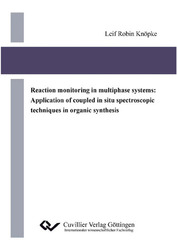| Departments | |
|---|---|
| Book Series (96) |
1378
|
| Nachhaltigkeit |
3
|
| Gesundheitswesen |
1
|
| Humanities |
2363
|
| Natural Sciences |
5406
|
| Mathematics | 229 |
| Informatics | 319 |
| Physics | 980 |
| Chemistry | 1363 |
| Geosciences | 131 |
| Human medicine | 243 |
| Stomatology | 10 |
| Veterinary medicine | 108 |
| Pharmacy | 147 |
| Biology | 835 |
| Biochemistry, molecular biology, gene technology | 121 |
| Biophysics | 25 |
| Domestic and nutritional science | 45 |
| Agricultural science | 1004 |
| Forest science | 201 |
| Horticultural science | 20 |
| Environmental research, ecology and landscape conservation | 148 |
| Engineering |
1791
|
| Common |
97
|
|
Leitlinien Unfallchirurgie
5. Auflage bestellen |
|
Advanced Search
Reaction monitoring in multiphase systems: Application of coupled in situ spectroscopic techniques in organic synthesis (English shop)
Leif Robin Knöpke (Author)Preview
Table of Contents, Datei (42 KB)
Extract, Datei (140 KB)
The benefit of coupling different in situ spectroscopic methods (ATR-FTIR / UV-vis / Raman
spectroscopy) is exemplarily demonstrated by the means of two reactions as application
examples: the Lewis acid mediated formal [3+3] cyclocondensation reaction of a diene with a
ketenacetale and the heterogeneously catalysed asymmetric hydrogenation of imines. For both
reactions new reactors (deep-temperature cell, probe autoclave) have been developed enabling
in situ measurements under real reaction conditions
For the [3+3] cyclocondensation reaction it was demonstrated that the nature of the
formed product depends on the different intermediates formed between the ketenacetal and
the acids (complexation or acid catalysed rearrangement reaction). Furthermore the
mechanisms of similar reactions (including other Lewis acids like AlCl3, Al2O3 and TiO2 or
substrates like N-salicylideneaniline) could be successfully elucidated.
The effectiveness of the hydrogenation depends on the specific interaction of the
tested ketimines with the phosphoric acid ester used as chiral modifer. This interaction is
mainly influenced by the used solvent and leads to the formation of a carbocation (CH3OH) or
a contact ion pair in (CH2Cl2, CF3CH2OH). Furthermore, the detected strong adsorption of
imines and modifier on the Pt/Al2O3 catalyst affect their efficiency and activity in the
reaction.
| ISBN-13 (Printausgabe) | 3954040298 |
| ISBN-13 (Hard Copy) | 9783954040292 |
| ISBN-13 (eBook) | 9783736940291 |
| Final Book Format | A5 |
| Language | English |
| Page Number | 140 |
| Lamination of Cover | matt |
| Edition | 1 Aufl. |
| Volume | 0 |
| Publication Place | Göttingen |
| Place of Dissertation | Rostock |
| Publication Date | 2012-02-21 |
| General Categorization | Dissertation |
| Departments |
Chemistry
|








